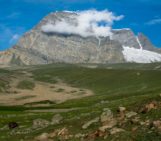
Every week, The Sassy Scientist answers a question on geodynamics, related topics, academic life, the universe or anything in between with a healthy dose of sarcasm. Do you have a question for The Sassy Scientist? Submit your question here or leave a comment below.
In a comment on a post about the key papers in geodynamics, the Curmudgeonly Commenter asked:
Could you please point out some exceptionally important papers in geodynamics and tell us something interesting about the history of the field?
Dear CC,
We can finally get into the interesting stuff. Let’s forget about the descriptions of earthquake kinematics last week and look at actual earthquake cycles now.
Beyond an elastic half-space… towards an earthquake cycle
Slip along fault planes is not restricted to earthquakes (i.e., co-seismic displacements) only; Smith and Wyss (1968) describe additional differential surface motion in the years following the 1966 Parkfield earthquake. So elastic half-spaces are all fun and games, but something else is happening. What about the underlying asthenosphere (Barrell 1914)? Doesn’t this — low-magnitude (Haskell 1935) — viscous material affect surface motions? Indeed. Nur and Mavko (1974) elaborated that the co-seismic phase is followed by a phase of transient, time-dependent deformation, dubbed the post-seismic phase. Thatcher and Rundle (1979) provide elaborate evidence for surface-breaking events that the earthquake cycle should include significant post-seismic surface motion, without the need for exotic fault or rock properties. What could these post-seismic processes be? Is it just viscous flow of rock layers at depth (e.g., Freed and Lin 2001), or do we need to look for other mechanisms, such as a combination of the presence of water inside rock pores at depth (Nur and Booker 1972; Peltzer et al. 1998), and a-seismic or micro-seismic slip on the same fault plane after a major event (Perfettini and Avouac 2004)?
Stick-slip and earthquake statistics
In terms of understanding earthquake nucleation rather than describing the after-the-fact surface deformations, Brace and Byerlee (1966) provided the next step to better explain the earthquake source: stick-slip. Stick-slip states that the differential motion on a fault plane between two blocks does not occur smoothly, but rather ‘jerky’, i.e., the roughness of the surface ensures that the two block stick together and when the fault ‘strength’ is overcome the fault fails and an earthquake occurs. Burridge and Knopoff (1967) subsequently provided a wonderfully simple analogue that simulates the statistics of earthquakes with both small-magnitude and major earthquakes, noting similar statistics as the empirical Gutenberg-Richter (1956) and Omori (1894) laws (Utsu 1961). Burridge and Knopoff (1967) conclude that a viscous component is necessary to produce aftershocks. Byerlee (1978) — yes, the guy from the law — relates the normal stress to the shear stress on the fault plane — quite an important inference, and a step beyond the Mohr-Coulomb failure law. In this, the smoothness of the surface and therefore the presence of asperities — i.e. friction — is paramount. Asperities — domains on fault interfaces that are locked (Lay et al. 1982) — and, especially, their spatial distribution control the seismogenic nature of a particular fault interface.
So, we’re actually getting somewhere. I think I’ve whetted your apatite, but you will have to wait another week before I start explaining how friction works.
Yours truly,
The Sassy Scientist
PS: This post was written after being stuck for a while, then released quickly through a sudden burst of energy, and then some transient editing of the text. I’ll put this on repeat for the forthcoming posts in this series.
References: Barrell, J. (1914), The strength of the crust, Part VI. Relations of isostatic movements to a sphere of weakness — the asthenosphere. Journal of Geology, 22, 655–683 Brace, W.F. and Byerlee, J.D. (19660, Stick slip as a mechanism for earthquakes. Science 153, 990–992 Burridge, R., and Knopoff, L. (1967), Model and theoretical seismicity. Bulletin of the Seismological Society of America, 57, 3411 Byerlee, J.D. (1978), Friction of rock. Pure and Applied Geophysics, 116, 615–626 Freed, A.M., and Lin, J. (2001), Delayed triggering of the 1999 Hector Mine earthquake by viscoelastic stress transfer. Nature, 411, 180–183 Gutenberg. B. and Richter, C.F. (1956), Magnitude and energy of earthquakes. Annals of Geophysics, 9, 1-15 Haskell, N. A. (1935), The motion of a fluid under a surface load, 1. Physics, 6, 265-269 Lay, T., Kanamori, H. and Ruff, L. (1982). The asperity model and the nature of large subduction zone earthquakes, Earthquake Prediction Research, 1, 3-71 Nur, A. and Booker, J.R. (1972), Aftershocks caused by pore fluid flow? Science 175, 885–887 Nur, A. and Mavko, G. (1974), Postseismic viscoelastic rebound. Science, 183(4121), 204–206. https://doi.org/10.1126/science.183.4121.204 Omori, F. (1894), On after-shocks of earthquakes. Journal of the College of Science, Imperial University of Tokyo, 7, 111-200 Peltzer, G., Rosen, P., Rogez, F. and Hudnut, K. (1998), Poro-elastic rebound along the Landers 1992 earthquake surface rupture. Journal of Geophysical Research, 103, 30131–30145 Perfettini, H. and Avouac, J.P. (2004), Stress transfer and strain rate variations during the seismic cycle. Journal of Geophysical Research, 109, B06402. https://doi.org/10.1029/2003JB002917 Smith, S.W. and Wyss, M. (1968), Displacement on the San Andreas fault initiated by the 1966 Parkfield earthquake. Bulletin of the Seismological Society of America, 58, 1955-1974 Thatcher, W. and Rundle, J.B. (1979), A model for the earthquake cycle in underthrust zones. Journal of Geophysical Research, 84(B10), 5540–5556. https://doi.org/10.1029/JB084iB10p05540 Utsu, T. A. (1961), Statistical study on the occurrence of aftershocks. Geophysical Magazine, 30, 521-605



